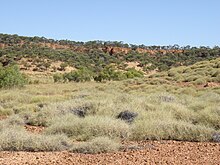|
Pseudonaja mengdeni
 The western brown snake (Pseudonaja mengdeni) is commonly known as Mengden's brown snake,[2] and alternatively, gwardar.[3] Pseudnaja mengdeni is endemic to Australia. It is highly variable in colour and patterns[2] and is a highly dangerous elapid whose bite can cause severe symptoms resulting in death.[4] It is one of the three species originally classified as Pseudonaja nuchalis along with P. aspidorhyncha, and P. nuchalis.[3] TaxonomyPreviously the western brown snake was considered a 'morph' form of Pseudonaja nuchalis, recent genetic studies have proven it to be genetically unique.[5] It is estimated that Pseudonaja nuchalis could include in excess of 10 different species.[5] Although currently there have been 8 species chromosomeally identified species these include: P. aspidorhyncha, P. mengdeni, P. imperator, P. acutirostris, P. gowi, P. carinata, P. kellyi and P. nuchalis.[5] DescriptionPseudonaja mengdeni grows up to a total length of 2m[2] with an average length 1.2m[5] It has slender body and narrow head.[6] Mengden's brown snake is highly variable in colour and patterns, ranging from light brown to almost black.[2] However it has two distinct forms ‘Orange with black head’ or ‘Pale head, grey nape’[3] The underside along the belly is often cream, yellow, orange, or grey in colouration, frequently consisting of dark orange or grey blotches.[2] Scales on the head often form a black V or W pattern.[6] Western brown snakes can be confused with the Eastern brown snake which has a pink mouth lining,[4] the Northern brown snake has a purplish/blue-black mouth lining.[7][8] P. mengdeni has a distinctive large strap-like scale around the front of the snout.[8] To accurately identify this species the scales around the mid-body and along the lips need to be counted. 180-230 ventral scales, 45-70 subcaudals with a divided anal scale and 17 or 19 rows of smooth mid-body scales.[2] However this must only be done by an experienced herpetologist, as a scratch from the fangs can still be fatal from P. mengdeni.[4] Confusion between the species is largely due to the possible hybridisation between the Pseudonaja species.[3] The western brown snake is often confused with other Pseudonaja spp. (brown snakes) and also Aspidites melanocephalus (black headed python).[3] Distribution and habitatFound from the coast of Western Australia through central Australia to the north-west of New South Wales and western Queensland. The species distribution is poorly defined within its northern limits;[2] however, it is absent from wetter areas of eastern Australia and south-western Western Australia.[9] Pseudonaja mengdeni is found throughout all dry to arid areas including, woodlands, boree woodlands, sandhill woodlands, mallee woodlands, spinifex deserts, spinifex-covered dunefields, sandplains, stony plains, croplands, grasslands and temperate sclerophyll forests.[2][10] The western brown snake often found within fallen timber, dead trees, shrubs, native grasses and ground cavities.[4]
DietPseudonaja mengdeni preys upon small reptiles, mammals, other snakes, ground nesting birds and bird eggs.[2] ReproductionPseudonaja mengdeni is oviparous and can lay up to in excess of 12 eggs per clutch.[5] VenomPseudonaja mengdeni has highly dangerous venom neurotoxic and haemotoxic[3] and can cause severe symptoms resulting in death.[4] Mengden's brown snake is considered dangerously venomous.[10] Antivenom used in case of envenoming is the brown snake Antivenom[11] If bitten first aid must be applied and medical attention sought. BehaviourPseudonaja mengdeni will rear their fore-body into an S-shape when threatened[10] lifting their head off the ground and open their mouth.[4] Is also a terrestrial species that is diurnal however it can be active on warm nights[4] References
|
|||||||||||||||||||||||||||||||||||




